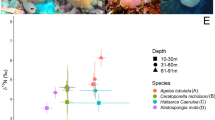Abstract
The diatom assemblage associated with the Antarctic sponge Mycale acerata was studied through an analysis of the diatom frustule and pigment concentrations in both the sponge ectosome and choanosome. Sponges were sampled weekly from November 2001 to February 2002 at Terra Nova Bay, Antarctica, at a depth of 25–35 m. The most abundant diatoms were Porannulus contentus, Fragilariopsis curta, Thalassiosira cf. gracilis, T. perpusilla and Plagiotropis sp. High abundances of P. contentus were found on the sponge ectosome up to the beginning of November, before the ice melted, while later frustules were incorporated inside, indicating that P. contentus lives epibiontically on M. acerata and represents a potential food source for the sponge. The presence of other diatom species was mainly related to the summer phytoplankton bloom. The sponge incorporates diatoms from the water column and utilises them as a food source, accumulating frustules inside the choanosome. The lack of planktonic diatom frustules at the beginning of the summer indicates that they are expelled or dissolved during the cold season.






Similar content being viewed by others
References
Amsler CD, McClintock JB, Baker BJ (2001) Secondary metabolites as mediators of trophic interactions among Antarctic marine organisms. Am Zool 41:17–26
Bavestrello G, Cerrano C, Cattaneo-Vietti R, Gaino E, Penna A, Sarà M (2000) Parasitic diatoms inside Antarctic sponges. Biol Bull 198:29–33
Cattaneo-Vietti R, Bavestrello G, Cerrano C, Gaino E, Mazzella L, Pansini M, Sarà M (1999) The role of sponges in the Terra Nova Bay ecosystem. In: Faranda F, Guglielmo L, Ianora A (eds) Ross Sea ecology Italiantartide Expeditions (1987–1995). Springer, Berlin Heidelberg New York, pp 539–549
Cerrano C, Arillo A, Bavestrello G, Calcinai B, Cattaneo-Vietti R, Penna A, Sarà M, Totti C (2000) Diatom invasion in the Antarctic hexatinellid sponge Scolymastra joubini. Polar Biol 23:441–444
Cerrano C, Calcinai B, Cucchiari E, Di Camillo C, Nigro M, Regoli F, Sarà A, Schiaparelli S, Totti C, Bavestrello G (2003) Are diatoms a food source for Antarctic sponges? Chem Ecol (in press)
Dayton PK, Robilliard GA, Paine RT, Dayton LB (1974) Biological accommodation in the benthic community at McMurdo Sound, Antarctica. Ecol Monogr 44:105–128
Gaino E, Rebora M (2003) Ability of mobile cells of the freshwater sponge Ephydatia fluviatilis (Porifera, Demospongiae) to digest diatoms. It J Zool 70:1–6
Gaino E, Bavestrello G, Cattaneo-Vietti R, Sarà M (1994) Scanning electron microscope evidence for diatom uptake by two Antarctic sponges. Polar Biol 14:55–58
Hamilton PB, Poulin M, Yang JR, Klöser H (1997) A new diatom genus Porannulus (Bacillariophyta), associated with marine sponges around King George Island, South Shetland Islands, Antarctica. Diatom Res 12:229–242
Hasle GR (1978) The inverted microscope method. In: Sournia A (ed) Phytoplankton manual monographs on oceanographic methodology 6. UNESCO, Paris, pp 88–96
Hasle GR, Syvertsen EE (1996) Marine diatoms. In: Tomas CR (ed) Identifying marine diatoms and dinoflagellates. Academic, San Diego, pp 5–385
Jackson JBC, Buss L (1975) Allelopathy and spatial competition among coral reef invertebrates. Proc Natl Acad Sci USA 72:5160–5163
Kowalke J (2000) Ecology and energetics of two Antarctic sponges. J Exp Mar Biol Ecol 247:85–97
Lorenzen CJ (1967) Determination of chlorophyll and phaeopigments: spectrophotometric equations. Limnol Oceanogr 12:343–346
Marino D, Cabrini M (1997) Distribution and succession of phytoplankton populations in the Ross Sea (Antarctica) during the austral spring 1994. In: Faranda FM, Guglielmo L, Povero P (eds) National Programme for Antarctic Research, Rossmize ‘93–’95. Data Report, pp 307–341
McClintock JB, Baker BJ (1997) An overview of the chemical ecology of shallow-water antarctic marine invertebrates. Am Zool 37:329–342
Nuccio C, Innamorati M, Lazzara L, Mori G, Massi L (2000) Spatial and temporal distribution of phytoplankton assemblages in the Ross Sea. In: Faranda FM, Guglielmo L, Ianora A (eds) Ross Sea ecology Italiantartide Expeditions (1987–1995). Springer, Berlin Heidelberg New York, pp 231–245
Sarà M, Bavestrello G, Cattaneo-Vietti R, Cerrano C (1998) Endosymbiosis in sponges: relevance for epigenesis and evolution. Symbiosis 25:57–70
Acknowledgements
The authors gratefully acknowledge F. Regoli, M. Nigro and S. Schiaparelli for collecting sponge specimens. This research was supported by PNRA and MIUR grants.
Author information
Authors and Affiliations
Corresponding author
Rights and permissions
About this article
Cite this article
Cerrano, C., Calcinai, B., Cucchiari, E. et al. The diversity of relationships between Antarctic sponges and diatoms: the case of Mycale acerata Kirkpatrick, 1907 (Porifera, Demospongiae). Polar Biol 27, 231–237 (2004). https://doi.org/10.1007/s00300-003-0581-1
Received:
Accepted:
Published:
Issue Date:
DOI: https://doi.org/10.1007/s00300-003-0581-1




